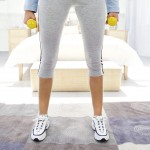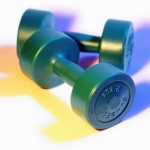 When it comes to lifting weights, doing the same old thing every day can get boring and make you tempted to skip workouts. If this is the case, give circuit training a try. Circuit training consists of taking 3-5 exercises and doing them consecutively with no rest in between. An example of this would be to perform push-ups, biceps curls, triceps dips and mountain climbers all in row, then rest for up to a minute before performing the same circuit 2-3 more times. Circuit training allows you to get more done in a shorter amount of time while keeping your heart rate up. Keeping your heart rate up for most of your workout means burning more fat the entire time spent working out. Add that to building muscle, and your body will be a fat burning machine.
When it comes to lifting weights, doing the same old thing every day can get boring and make you tempted to skip workouts. If this is the case, give circuit training a try. Circuit training consists of taking 3-5 exercises and doing them consecutively with no rest in between. An example of this would be to perform push-ups, biceps curls, triceps dips and mountain climbers all in row, then rest for up to a minute before performing the same circuit 2-3 more times. Circuit training allows you to get more done in a shorter amount of time while keeping your heart rate up. Keeping your heart rate up for most of your workout means burning more fat the entire time spent working out. Add that to building muscle, and your body will be a fat burning machine.
There are endless ways to create circuits, even adding in plyometric moves or treadmill sprints to your circuits to log cardio while lifting weights. Choose the cardio machine you like the best and after each circuit do 1-2 minutes at a high intensity to get your heart rate up. Working out this way also makes the time fly by and keeps workouts interesting. If you don’t have hours to burn at the gym, circuit training is going to be the best thing for your goals and your schedule.
Here is a sample circuit training workout:
Squat with dumbbell shoulder presses- 15 reps
Seated on stability ball biceps curls- 15 reps
Plank holds- 45 seconds
1-2 Minutes treadmill sprints
*Repeat 2-3 times
Create the circuits that fit your weekly workout schedule. Stick with the same schedule for 4 weeks, and then change it up to keep from getting bored and to keep your body challenged!
Angelena is a mom, healthy living blogger at On Fire Fitness Healthy Living (www.OnFireFitnesspt.com), a NASM Certified Personal trainer and Fitness Nutrition Specialist. Her goal is to inspire others to take the steps to living a healthy lifestyle. Visit Angelena on Facebook and on Twitter.
 Subscribe
Subscribe







